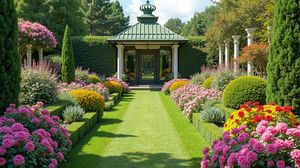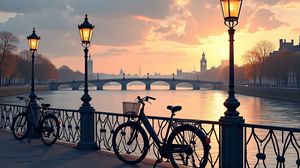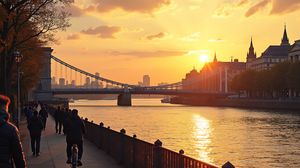
The Battersea Park Peace Pagoda is a striking and serene monument nestled within the lush greenery of Battersea Park, one of London's most delightful open spaces. It was designed to promote peace and tranquility, standing as a beacon of harmony amidst the bustling city backdrop. The pagoda forms part of a series of similar structures built by the Buddhist organization Nipponzan Myohoji as a testament to global peace efforts, following the devastation of World War II and the bombings of Hiroshima and Nagasaki.
Opened in 1985, the Battersea Park Peace Pagoda was the first of its kind to be constructed in mainland Europe, marking London's commitment to promoting peace. This towering pagoda is adorned with carved stone images that depict various scenes from the life of Siddhartha Gautama, the historical Buddha. Its golden Buddha statues radiate a peaceful presence, offering visitors a perfect spot for quiet contemplation and reflection.
Interestingly, the pagoda's construction was initiated and completed with the volunteer efforts of monks, nuns, and other practitioners, making it not only a symbol of peace but also of collective human effort and cooperation. Visitors may be surprised to learn that the structure was gifted to London by the Venerable Nichidatsu Fujii, a Japanese monk who was deeply inspired by Mahatma Gandhi's principles of nonviolence.
The pagoda stands majestically by the River Thames, offering sweeping views of the river and the iconic Chelsea Bridge. These vistas, combined with the park's natural beauty, make the pagoda a popular spot for photography enthusiasts and those seeking a moment of peace in a busy city.
It's interesting to note that the Peace Pagoda does not have any interior space that can be accessed. Unlike traditional Buddhist pagodas that may contain relics or serve as temples, this monument is purely symbolic and meant for exterior viewing. Visitors often find themselves mesmerized by the contrast between the pagoda's intricate architectural details and the vast openness of the park's landscape.
Battersea Park Peace Pagoda also serves as a poignant reminder of the continuing need for peace efforts around the world. It periodically hosts peace ceremonies and vigils that are open to the public, promoting messages of unity and reconciliation among diverse communities. These events provide a unique cultural experience and insight into the shared global pursuit of peace.

Making the Most of Your Visit:
Make sure to stop by in the early morning or late afternoon when the light is softer. This not only provides fantastic photography lighting that accentuates the pagoda's stunning details, but also gives a more serene atmosphere, away from the larger daytime crowds.
Combine your visit with a walk along the River Thames for breathtaking views of the pagoda against the backdrop of the river and Chelsea Bridge. The tranquil riverside stroll enhances the peaceful vibes of your pagoda visit.
If you're visiting on a weekend, check ahead to see if any peace ceremonies or vigils are scheduled. These events offer a unique opportunity to experience the cultural and spiritual context of the pagoda firsthand, and they're open to the public.
Take a moment to sit on a nearby bench and enjoy some quiet time. The area around the pagoda is perfect for meditation, reading, or simply enjoying nature. It's one of the best spots in Battersea Park for personal reflection and to take a break from the city's hustle and bustle.
Bring along a picnic! The lawn areas of Battersea Park nearby are wonderful for an al fresco lunch or snack. You'll find yourself surrounded by nature and tranquility, with the magnificent pagoda as a view—it's a lovely way to extend your visit.

Visiting Times & Costs:
The Battersea Park Peace Pagoda is open to the public and can be visited at any time. The park itself is typically open from dawn till dusk, allowing ample opportunity to visit the pagoda during daylight hours.
There is no charge for visiting the pagoda. It is part of the public space within Battersea Park, which is free to enter.
Regarding accessibility, the pagoda is situated within Battersea Park, which has paved paths and is largely accessible for visitors with mobility impairments. However, visitors should be aware that some areas around the pagoda may be on uneven ground, typical of outdoor park settings.

Address & Map:

Nearby:























